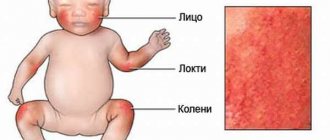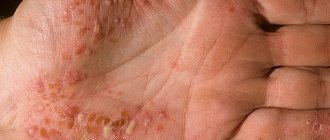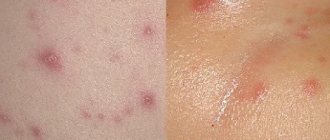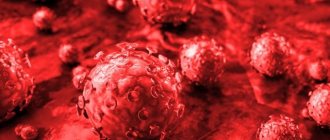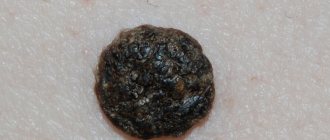Basics of home child care
When caring for a sick child, you need to adhere to certain rules.
The child’s diet should be high in calories, but with a limit on “fast” carbohydrates. Difficult-to-digest carbohydrates are included in the diet as a replacement for limited foods. Avoid foods that increase intestinal fermentation: legumes, cabbage, cheeses. When ulcers and abscesses appear on the face, liquid food is prepared for the patient. At the same time, facial movements (talking, laughing) are limited. The diet is supplemented with vitamins, newborns are often put to the breast.
Before using external agents, the lesions are thoroughly washed with an antiseptic solution using a syringe. At the same time, the old layer of ointment is removed and the peeled crusts are removed. Gauze dressings are changed 3 times a day.
The baby's diapers and clothes are sterilized and ironed on both sides. They are replaced several times a day. The child’s personal towels are replaced with disposable ones, and soft toys are removed. Contact with the patient is carried out only in clean clothes with pre-disinfected hands.
When ulcers are localized in the scalp area, the patient's hair is cut short. Shaving is excluded. Nails are cut with sterile scissors, and the tips are lubricated with iodine every day.
During the period of acute manifestation of pyoderma, bathing the child is prohibited. Water, penetrating under crusts and microcracks, promotes the rapid proliferation of bacteria. Bathing is replaced by treating the skin with antiseptic solutions or herbal decoctions.
Types and symptoms
Damage to the epidermal layer in pyoderma can be either superficial or deep, and the nature of the disease can be acute or chronic. Depending on the presence of a particular pathogen, three types of disease are distinguished:
- staphylococcal - staphyloderma,
- streptococcal - streptoderma,
- mixed - streptostaphyloderma.
In the photo below you can see what the main signs of the streptococcal form look like in adults.
Staphylococcal pyoderma is usually accompanied by infection of the superficial layers of the skin. Its varieties are the following diseases:
- Ostiofolliculitis is damage to the hair follicle with the formation of purulent pustules. Most often it appears on the face in the area of the beard and mustache, as well as on other parts of the body where hair growth is possible. After the ulcers disappear, there are no scars left.
- Folliculitis is the appearance of red papules in place of the hair follicles, transforming into nodules with gray-green pus. After the inflammatory process subsides, a scaly spot forms, and then a scar.
- Vesiculopustulosis is an infection of the sweat glands. Mostly occurs in newborns and children under three years of age. At the site of the lesion (armpits, groin or under the hair on the head), prickly heat begins, and then pustules form.
- Sycosis is a chronic inflammation of the hair follicles with periodic relapses. Affects the scalp, skin of the mustache, eyebrows and beard, and groin area.
- Furunculosis is the formation of inflamed, painful nodules with purulent contents - boils. Possible fever and headaches. It affects individual parts of the body (neck, buttocks, forearms), but can also be generalized.
- Carbuncle is a purulent-necrotic inflammation of several hair follicles simultaneously with the formation of an extensive infiltrate filled with pus. The disease is accompanied by high fever, nausea, vomiting, and neuralgic pain.
- Hidradenitis is the formation of an infiltrate on the sweat glands with a channel for the secretion of pus. There is redness of the skin, swelling, increased body temperature, and general malaise. The disease is chronic with periodic relapses.
Streptococci affect the upper layers of the skin, forming phlyctenas - blisters filled with exudate
. The most common types of streptoderma include:
- Fox's impetigo is a highly contagious disease that affects not only the skin, but also the mucous membranes of the mouth, nose, eyes and bronchi.
- Zaeda is a slit-shaped erosion located in the corners of the mouth. Accompanied by redness, swelling, and is often chronic.
- Lichen simplex is the appearance of pink spots covered with small scales on the face, arms and legs. Usually occurs in children in the spring.
- Paronychia is an infection of the nail fold with the formation of blisters. The skin takes on a bluish tint, and the nail plate becomes dull and deformed.
- Erysipelas is a lesion of the subcutaneous fat layer and lymphatic vessels. The skin is scarlet in color, hot to the touch, reminiscent of the peel of an orange.
- Cellulite - affects the legs and face, causing swelling, redness, and blistering. It occurs with fever, chills, and severe pain.
- Ecthyma - single or multiple blisters concentrated on the legs and buttocks. When phlyctena dries out, ulcers form and then scars.
People with particularly weakened immune systems may experience simultaneous exposure to streptococcal and staphylococcal infections. In these cases, the deep layers of the skin are affected with a tendency to peripheral growth. There may even be ulceration of the epidermis.
The most common sign of the disease in children is a rash in the form of yellow purulent dots, in place of which purulent blisters form, drying out to form crusts.
If left untreated, an ulcer may appear at the site of the bladder, and then a scar. Other symptoms of the disease in a child include:
- itching and burning,
- skin redness,
- soreness,
- swelling.
Symptoms of pyoderma in young children can be seen in the photo below.
Main manifestations
Pyoderma in children, the symptoms of which are the same as in adults, has a variety of manifestations. First of all, a change in skin color occurs. At the first stages it is a reddish tint; as the disease progresses, the skin becomes covered with various rashes, in most cases they look like blisters containing pus. If adequate treatment is not carried out, these blisters will burst, after which an ulcer will form that does not heal for a long time.
If pyoderma in a child on the face or other area is chronic, for example, due to staphylococcus, then after recovery scars remain on the skin.
A successful result is possible only with complete and timely treatment, as well as proper care for the child.
Diagnosis of pyoderma
As you can see, pyoderma has similarities with other skin diseases. Therefore, it is better not to self-medicate, and at the first purulent formation, consult a specialist.
In order to make a correct diagnosis, you need to visit several doctors:
- First of all, a dermatologist who: Checks with the patient and his immediate family for the presence of diseases of the endocrine system, weakened immunity, and lack of vitamins.
- Carefully examines the affected area.
- Gives directions for: bacteriological culture,
- culture for sensitivity to antibiotics,
- general blood test with leukemia formula and general urinalysis,
- blood sugar level.
- An endocrinologist, he examines hormonal levels.
- An immunologist is referred to him only when the infection is difficult to treat, or if the child often suffers from this disease. It gives direction to determine the level of immunity.
- Pediatrician - based on the obtained tests, makes a general conclusion after all the specialists. Makes a list of activities aimed at restoring health.
ointments and creams with antibacterial action, which include ichthyol, tar;- iodine, brilliant green;
- boric, camphor, salicylic alcohol;
- potassium permanganate and sodium sulfate;
- immunostimulating drugs;
- antibiotic ointment containing erythromycin and lincomycin.
Treatment is carried out using the following means:
MORE ABOUT: Folk diuretics at home
You might be interested! Pemphigus in children: causes, symptoms and treatment
General recommendations:
- Moisture should not be allowed to come into contact with the affected areas of the skin; as an exception, herbal compresses can be used;
- on skin where there are pustules, it is necessary to remove hair with scissors; you cannot shave;
- nails are cut short and treated with iodine, as dirt collects there;
- exclude from the diet foods that can cause allergies and difficult to digest foods;
- compliance with personal hygiene rules.
Diagnostics
The diagnosis is made by a doctor based on the collected medical history, examination of the affected areas and laboratory tests. The child is given directions for general blood and urine tests. If necessary, pus is taken for analysis - this will determine the pathogen and its sensitivity to antibiotics.
For additional consultation, the baby will be asked to visit the offices of a pediatrician, endocrinologist, neurologist, or surgeon (in case of deep damage).
For frequent manifestations of pyoderma, you will need:
- microbiological analysis of purulent contents;
- biochemical analysis of blood and urine;
- appointment of an immunogram.
How to treat pyoderma?
Treatment of pyoderma is carried out under the supervision of qualified specialists. As a rule, the doctor prescribes medications for external and internal use, including restoration of immune strength.
General uses:
- diagnosis and treatment of concomitant diseases (hormonal imbalance, diabetes, immunodeficiency);
- elimination of adverse effects on the skin (damage, pollution, exposure to high or low temperature);
- nutrition with a limitation of refined carbohydrates, a predominance of proteins, plant fiber, and fermented milk products;
- prohibition of washing (shower, bath), you can only wash local unaffected areas of the skin with great care so as not to spread the infection;
- trimming hair in the affected area;
- treating the skin around the ulcers twice a day with a solution of salicylic alcohol.
A special low-carbohydrate diet must be followed. The following medications are used to treat various types of pyoderma:
- It is recommended to carry out antibiotic therapy using semisynthetic macrolides, Penicillin, Tetracycline, aminoglycosides, and latest generation cephalosporins);
- in case of severe development of the disease, glucocorticosteroid drugs are used (Hydrocortisone, Metipred, etc.);
- for pyoderma, hepatoprotectors are prescribed (Essentiale Forte, Silibor, etc.);
- the use of angioprotectors (Actovegin, Trental) is recommended;
- cytostatics (Methotrexate) are prescribed.
To antisepticize erosive ulcerations, it is necessary to use ointments with a bactericidal effect. Most often used in the treatment of pyoderma:
- zinc ointment or salicylic-zinc paste;
- Levomekol;
- tetracycline ointment;
- lincomycin ointment;
- erythromycin ointment;
- hyoxysone ointment, etc.
In addition, there are drugs for complex treatment that have antibacterial, anti-inflammatory and antifungal effects. The most popular ointments are Thymogen and Triderm. When pyodermitis is accompanied by the appearance of ulcers, the inflammatory foci should be washed aseptically after removing the scab (Tannin, Furacilin, boric acid, Dioxidine, Chlorhexidine, etc.).
For carbuncles, boils, hidradenitis, you can apply a sterile bandage with Ichthyol Dimexide, Chymotrypsin and Trypsin to the affected area. In addition, a Tomicide bandage is often applied to the affected parts of the body.
Classification of the disease
There are many types of pyoderma, this is due to the causes of the pathology and the depth of damage to the tissue layers. Thus, according to the depth of pyoderma wounds, there are:
- primary (occurs on healthy skin);
- secondary or complicated (are a complication of an existing pathology).
With timely detection and treatment, primary pyoderma is well cured, and no scars remain on the epidermis. Complicated pathology is often accompanied by deeper penetration of harmful microflora, which complicates treatment. After the wounds tighten, scars and age spots form on the skin.
In order to avoid complications and the penetration of pathological cocci inside, it is forbidden to scratch wounds on the body that itch.
Most often, pyoderma is complicated by diseases such as scabies, diabetes mellitus, eczema, and chronic renal failure.
Types based on pathogens
The main cocci that can cause this pathology are streptococci and staphylococci. Based on this, there are two groups of pyoderma.
The group of diseases caused by staphylococci (staphyloderma) is represented by a number of diseases.
Ostiofolliculitis. This pathology begins with inflammation that occurs near the mouth of the hair follicle. First, redness is observed, which is replaced by a follicle measuring 2-3 mm, which is penetrated by a hair. At the next stage, the formation dries out and a crust forms, which disappears after a while.
Most often, such formations are observed in pediatric dermatology, less often in adults. In children, ostiofolliculitis forms in areas of scratches, scratches, insect bites, etc. In men - in the area of the beard, mustache, and neck.
Ostiofolliculitis can be characterized by a large number of foci of inflammation or singly. As a rule, this pathology precedes a more serious inflammatory process such as sycosis.
Sycosis in the photograph
Sycosis. If ostiofolliculitis is, as a rule, solitary rashes that disappear over time without significant consequences, then sycosis is a long-term, often recurrent disease that occurs in the neck and face. As a rule, it manifests itself in men and children, less often in women. Sycosis is chronic in nature and after long-term treatment, it may reappear after some time, in the presence of conditions favorable to the pathology (lowered immunity, taking antibiotics, etc.).
The disease is characterized by the appearance of pustules on the skin of the face and neck, which are located near the hair follicles. Further, these pimples become more and more numerous, this is due to allergic reactions that occur under the upper layers of the dermis.
At the same time, pathogenic cocci spread throughout the body. As a rule, the causative agent of this type of pyodemia is Staphylococcus aureus. As the pathology progresses, the sensitivity of the follicles decreases, as well as sweating in the affected area deteriorates.
The cause of sycosis can be cuts and microtraumas, which are often observed after shaving. Conjunctivitis can also cause sycosis on the skin of the eyelids. This disease also often occurs in the inner part of the wings of the nose, and is associated with plucking of nasal hairs. Frequent runny noses can cause pathology to appear on the upper lip.
Folliculitis
Folliculitis. Folliculitis, like other types, is associated with infection penetrating the skin. The peculiarity of this tissue structure disorder is that it can be caused by bacteria, fungi, viruses, and parasites. The pathology is characterized by inflammation in the lower and middle parts of the follicle.
Redness occurs around the hair follicle, which turns into pustules; they can be single and merge into one. In the center of the inflammation, an abscess with characteristic whitish or yellow pus is formed. After opening the pustule, the wound tightens and heals at the site of the abscess. Deep pimples leave characteristic scars.
In countries with hot climates, the risk of folliculitis is much higher than in other countries. This is due to the fact that the climate itself promotes the development of many pathogenic microorganisms. A high risk of developing the disease is also observed in dysfunctional families.
Furuncle. The occurrence of boils is an even more common purulent skin lesion. A boil can occur not only near the hair follicle, but anywhere on the body.
Such pimples often appear in areas of important blood vessels or lymph nodes.
The process of a boil begins with the appearance of redness, which is initially painful. Next, a painful node is formed, which can reach the size of a walnut.
After this, the pimple opens and pus is visible in the middle of the shaft along with particles of dead skin. The boil does not heal for a long time and makes itself felt by pain. After the pimple wound heals, a scar remains in its place.
The occurrence of a boil can lead to many serious consequences, including blood poisoning - sepsis. In the case when the boil affects the tissue in the plexus of lymph nodes (neck, collarbone area, lower part of the face, groin area, etc.), there is a risk of lymph infection.
Places of plexus of blood vessels are also favorable for the penetration of infection - the area of the armpits, collarbones, nasolabial triangle, inguinal, temporal zones, etc. In these places there are the main blood lines, which are closest to the surface.
When staphylococci enter the bloodstream, sepsis and infection of the main organs of human vital activity can occur.
Frequent recurrences of boils on the skin may indicate a malfunction of the immune system. This disease is called furunculosis and may be associated with an allergic reaction of the body to staphylococci.
Carbuncle. This type of epidermal lesion differs from a boil in the greater spread of infection. In place of the old boil, deep damage to the muscles, fascia and subcutaneous tissue occurs down to the dermis and hypodermis. Pus accumulates and spreads under the tissues, after which it begins to appear on the surface, released from the pores. Over time, the pus-affected skin begins to peel off and a large ulcer forms.
What does hidradenitis look like?
Hidradenitis. Hidradenitis is another skin pathology that is associated with the accumulation of staphylococci under the skin. As a rule, suppuration forms in places of greatest sweating - in the armpit, labia, groin and perianal area.
Initially, a painful tumor forms, which over time expands and opens with the release of purulent-necrotic fluid. Most often this disease occurs in the armpit area.
This is due to the fact that in these places the largest number of bacteria accumulate, which could cause suppuration. In addition, micro-wounds often form on the armpits, which allows the infection to penetrate deep into the dermis.
Treatment of pyoderma - drugs and methods
Before you begin to treat the disease, you need to pass all tests to determine the pathogen that caused the disease. You should not self-medicate so as not to harm your health. Many treatment methods have been identified. This can be local or systemic therapy.
Some people prefer home alternative treatment, but only after consulting a doctor.
Local therapy consists of the following procedures:
- Treatment of the skin with iodine.
- Rubbing a healthy area of skin with alcohol (Camphor, Boric).
- Using ointments for severe itching (Oxycord, Lorinden).
- Body lotions and baths for limbs based on potassium permanganate.
- Applying bandages with ointment for large ulcers (Ichthyol, Vishnevsky).
- Removing crusts with ointment (Tar, Sulfur).
- Use of antibacterial ointments to prevent infection (Lincomycin, Erythromycin).
If the disease is severe and has complications, the doctor may prescribe systemic therapy to the patient. For the treatment of severe cases, the following medications are recommended (possible examples are given in parentheses):
- Immunostimulating (Immunal, Amiksin).
- Antibacterial (Neomycin, Lincomycin).
- Cephalosporins (Kafzol, Suprax).
- Antihistamines (Zodac, Zyrtec).
- Sulfonamides (Biseptol).
In addition to taking these drugs, the doctor may prescribe the following procedures: paraffin therapy, immunotherapy, ultrasound irradiation and autohemotherapy.
Treatment with folk remedies involves the use of homemade ointments, lotions and gels. It is worth noting that traditional methods often cause allergies, and therefore before using them you need to do a skin test. One effective method is to wipe the affected area with aloe juice.
Treatment of pyoderma in children and adults: antibiotics and ointments, skin treatment
Treatment of the disease is carried out after determining the form and severity. There is no need to prescribe antibiotics here, since they are global eliminaters of staphylococci and streptococci.
The treatment method is divided into:
- drugs with local action
- antibiotic therapy
- immunotherapy
- surgical intervention
- using traditional medicine. If the surface layers of the skin are affected, topical medications, such as antibiotics and ointments, are prescribed.
Before treatment, the wound should be cleaned and treated, and all pustules should be opened.
Alcohol solutions, antimicrobial preparations, gels, and ointments are also used for treatment.
- Salicylic acid, in the form of a topical ointment, will help soften the affected layer and actively influence wound healing. Has anti-inflammatory effect and suppresses bacteria in the skin
- Diamond green is an alcohol-based medicine for external use. Actively fights the growth of pyoderma bacteria.
- Fukortsin is a special solution for suppressing bacteria and antifungal effects. Apply to painful areas, after drying, supplement treatment with ointment.
- Chlohexdine is a gel drug that promotes the complete elimination of growth-related bacteria, destroying active ones in the blood and pus.
- Triamcinolone is a cream for external use. A glucocorticoid drug to suppress the inflammatory process, intensively reduces allergies. Drugs with a combined effect on the focus of pyoderma include fucicortigioxin. Ointment with anti-inflammatory effect, to suppress streptococcostaphylococci.
Pyoderma
For mild to moderate pyoderma, oral antibiotics are prescribed. For severe forms of pyoderma, intravenous injections are used. Penicillins are recommended for oral use: amoxicillin, ampiox. As well as cephalosporins and itertacyclines. They are prescribed to disrupt the integrity of bacterial walls, suppress the growth of bacteria and destroy staphylococci at the cellular level.
Immunotherapy is also important in treating the disease in children and adults.
This is a treatment method based on drugs that stimulate immunity to the action of pathogenic microorganisms. Occurs in cases of chronic disease with possible exacerbation again. The immunotherapy program includes the following drugs: anatoxin and staphylococcal vaccine, streptoistaphylococcal bacteriophage, leukinferon.
Localization of the disease
Pustular skin diseases can have different localizations: limbs, scalp and body, face, skin folds, armpits:
- Pyoderma of the scalp (the most common form in infants) begins with small ulcers that are located in the middle of the follicle. Later, an inflammatory process occurs in the hair follicles (ostiofolliculitis, folliculitis). The skin turns red, the lesion becomes wet, and an inflamed purulent core is noticeable in the middle.
- Pyoderma on the face and other parts of the body is characterized by superficial lesions of the smooth dermis, which is not associated with the hair follicle and sebaceous duct. Phlyctens are formed - blisters with turbid liquid, surrounded by a reddish inflammatory border. Over time, the conflict itself opens and the contents flow out of it. In place of the phlyctena, a serous-purulent crust appears, which dries out and disappears after a couple of days. If this form of pyoderma is not treated, various pustular complications may develop: boils, carbuncles, sycosis, impetigo, ecthyma, lichen.
- Localization of the pathological process in the area of the armpits, anogenital area (hidradenitis) is purulent inflammation of the apocrine sweat glands. An inflamed, painful red-blue nodule forms, from which a large amount of pus comes out. The process is accompanied by regional lymphadenitis.
Sources
- https://zdrav-lab.com/piodermiya/
- https://cleanskin.online/virusologija/lechenie-piodermij.html
- https://dozhdalis.ru/piodermiya-u-detey-simptomyi-i-lechenie.html
- https://medictime.ru/stafilodermiya/
- https://www.KrasotaiMedicina.ru/diseases/zabolevanija_dermatologia/staphyloderma
- https://healthperfect.ru/piodermiya-u-detey.html
- https://KozhaExpert.ru/piodermiya/u-detej-2
- https://dermatologiya.pro/gnoinye-vospaleniya/piodermiya/
- https://adviceskin.com/zabolevaniya-kozhi/piodermii-u-detej.html
- https://la-kry.ru/spravochnik/syp/stafilodermiya-u-detey/
- https://heaclub.ru/chto-takoe-piodermiya-piodermiya-u-detej-novorozhdennyh-vzroslyh-prichiny-simptomy-i-lechenie
- https://facey.ru/deti/piodermiya.html
- https://o-krohe.ru/bolezni-rebenka/piodermiya/
- https://KozhaExpert.ru/piodermiya/simptomy-lechenie
- https://malutka.pro/bolezni/dermatologicheskie/piodermiya.html
- https://chebo.pro/zdorove/simptomy-i-lechenie-piodermii-u-detej.html
Types of pyoderma
Depending on the causes, symptoms and severity of the disease, several types of this disease can be distinguished:
- Periporitis, or vesiculopustulosis. The first stage of the disease is miliaria vulgaris, which occurs due to excessive sweating. During prickly heat, the ducts of the sebaceous glands are affected, after which raised points, so-called pustules, form on the skin. This type of pyoderma can affect large areas of the skin, most often the folds and scalp. But, despite this, the patient’s general condition is not affected, and treatment takes no more than three days.
- Streptococcal impetigo. This type of pyoderma is caused by scratching the insect bite. Other causes are scabies, atopic dermatitis. You can become infected with this type of disease through shared objects. Impetigo has characteristic manifestations - a pustular rash, absolutely flat, the size of the spots is up to 1 cm. The pus that is inside eventually shrinks into crusts, which fall off and leave a pink spot in this place, not scars. Most often it occurs on the skin of the face and mucous membranes. If a pustular rash appears on the scalp, after the ulcer heals, baldness may occur for some time.
- Angular stomatitis, or seizures. This type of disease has a special location of pustular vesicles. They open quite quickly, resulting in the formation of cracks, which cause a lot of discomfort. In addition, it is very contagious and is transmitted through household items. There is a danger of the disease becoming chronic due to the fact that minor mechanical injuries in these places can be observed during eating. The causes of the disease in general are rhinitis, inflammatory processes in the eyes and lack of vitamins.
Drug therapy for pyoderma
Pyoderma in children, the symptoms and treatment of which are individual and depend on the general condition of the body, immunity, the presence of concomitant diseases, and drug tolerance.
Only a dermatologist can prescribe complex drug treatment for pyoderma after confirming the diagnosis.
MORE ABOUT: How to feed your baby expressed milk if the mother is at work. How to warm up expressed milk. How to store expressed milk
The basic principles of effective treatment are:
- Impact on the cause of the disease (antimicrobial agents).
- Elimination of predisposing factors.
- Preventing the spread of infection to healthy skin.
Main groups of drugs:
1. Antibiotics. It is mandatory to prescribe antibacterial drugs orally (or intramuscularly) for:
- pronounced intoxication syndromes;
- elevated temperature;
- protracted chronic process;
- extensive affected areas;
- localization on the face;
- complications (lymphadenitis, lymphangitis).
For a better therapeutic effect, it is necessary to culture the site of inflammation to determine the pathogen and its sensitivity to the antibiotic. The course of treatment depends on the severity of the pathological process, but should last at least a week.
Until the results of the study are obtained, the latest generation of broad-spectrum antibiotics can be used:
- Cephalosporins: cephalexin, ceaclor, cefazolin, ceftriaxone.
- Macrolides: erythromycin, clarithromycin.
- Tetracyclines: doxycycline.
- Fluoroquinolones: ciprofloxacin, ofloxacin, levofloxacin.
- Lincosamides: clindamycin.
2. Sulfonamides. Drugs in this group also have a bacteriostatic effect, although they are less effective in the treatment of pyoderma. They are prescribed if the child is intolerant to antibiotics (norsulfazole, sulfazine).
3. Specific immunotherapy (staphylococcal antifagin, staphylococcal toxoid, bacteriophage, staphylococcal and streptococcal vaccines, antistaphylococcal plasma, lycopid, tactivin, thymalin). The drugs are indicated to stimulate the immune system in chronic, sluggish forms, with remission of less than 3 months in combination with local treatment of purulent elements. Contraindicated for heart defects, diseases of the gastrointestinal tract, liver and kidneys, tuberculosis.
4. Topical corticosteroids (applied topically to inflammatory areas in the form of creams, ointments) and systemic (taken orally in the form of tablets). Corticosteroids have anti-inflammatory, antiallergic, antipruritic effects. Used in combination with antibiotics for highly active, recurrent, chronic forms with severe itching (prednisolone, hydrocortisone acetate, betamethasone, butyrate).
5. Multivitamins (Multitabs, Suprastin, Biovital, Vitrum, Pikovit).
6. Hepatoprotectors. Prescribed in combination with antibiotics in severe forms of the disease to support liver function (Enerliv, Karsil, Antral, Essentiale).
Drug treatment of pyoderma
Once the diagnosis has been established, treatment is prescribed taking into account the age and individual characteristics of the patient and the degree of skin damage. The complex of therapeutic measures consists of immunomodulating agents, oral and topical medications, and a nutritious diet with a low amount of carbohydrates. Treatment (local skin treatment) and care:
- Treatment of purulent inflammations with drying agents of antiseptic action (potassium permanganate, salicylic acid, brilliant green, ichthyol ointment).
- Do not wet inflamed skin.
- Apply care products at regular intervals.
- Avoid repeated injury and scratching of the skin.
If local treatment is not enough, the child’s condition worsens, and the affected areas grow, then broad-spectrum antibiotics are recommended. The dosage and duration of the course are determined by the doctor. No matter how much you would like to prescribe medications yourself, you cannot do this. Self-medication is generally dangerous, and uncontrolled use of antibiotics in children is doubly dangerous. Pyoderma in newborns requires a particularly careful approach to treatment. It is recommended to iron linen, avoid clothes that can damage areas of inflammation, promptly treat wounds, change diapers (feces and urine irritate the skin, the disease can progress). In some cases, a surgical solution to the problem is recommended - opening the ulcers and cleaning the source of inflammation, followed by disinfecting treatment.
ethnoscience
Alternative medicine can be used in the auxiliary treatment of mild forms of pyoderma. In more severe forms, they do not bring a therapeutic effect and can only complicate the course of the disease.
For their preparation, herbal ingredients are used to eliminate itching, swelling and pain. They have regenerating, antiseptic and anti-inflammatory properties.
Recipes:
The raw and peeled vegetable is grated on a fine grater. The medicinal mass is placed in gauze and tied to the affected areas for 2 hours. The procedure is repeated 3 times a day for 10 days.
Dried raw materials (2 tablespoons) are poured with boiling water (0.5 l) and left for 15 minutes. Apply the strained and cooled product to the affected areas 3 times a day. Treatment is carried out until a positive result.
Dry roots and leaves of the plant (2 tsp) are poured with water (250 ml), boiled over low heat for 10 minutes and left for 8 hours. The infusion is taken 3 times a day, 50 ml separately from meals.
Chopped fresh leaves (2 tbsp) are mixed with sunflower oil (100 ml) and left for 3 hours. Apply the mixture to the affected areas 3 times a day. Duration of treatment is 20 days.
The plant juice is mixed 1:1 with chilled boiled water. Used in the form of lotions, which are applied to the affected areas for 1 hour 2 times a day.
The dry raw materials, ground to a powdery state, are combined with petroleum jelly (1: 2). Abscesses are lubricated with ointment 2 times a day.
Chamomile, mint and sage are mixed in equal proportions. The finished collection (1 tablespoon) is poured with boiling water (0.5 l), left for 30 minutes in a thermos. The strained product is applied to the affected areas 2-3 times a day.
Before using each product, the ulcers are washed with a 1% solution of potassium permanganate. The procedures are carried out under completely sterile conditions.
General information about pyoderma
The term “pyoderma” has Greek roots; it means “purulent skin,” which very accurately and specifically characterizes the peculiarity of the pathology. Suppuration on the skin is provoked due to the activity of special coccal bacteria. They belong to the flora widespread in the external environment, they are part of the opportunistic flora of the skin, they can never be completely removed from the skin, even if hygiene is carefully and meticulously observed, they again enter the skin from the external environment.
note
Infection is possible not only in children; coccal flora provokes suppuration of the skin in adults. But due to the specifics of immunity, frequent trauma to the skin and the peculiarities of its structure in children, pyoderma is more common in them. The skin is thinner, the hydrolipid layer is imperfect, and there are insufficient local immune factors that protect against cocci aggression.
The younger the age of the children, the weaker the protective functions of the epithelium are expressed; the most severe pyoderma can occur up to a year.
It is believed that more than 100 million children worldwide suffer from various types of pyoderma per year; there is not much difference between the incidence rate in developed and developing countries. Climate has a greater influence, with hot and humid regions usually showing statistics of more severe infections. This is associated with sweating and oily skin, which often complicates the course and makes the lesions more widespread.
Important
According to doctors, pyoderma in childhood is often associated with defects in care or inappropriate attitude towards children’s hygiene. Most often it occurs during the newborn period, accounting for up to half of all inflammatory processes in the epidermis.
Features of caring for affected skin of a child
The symptoms and effectiveness of treatment for pyoderma in children depend on the care of purulent lesions, so all manipulations with it are aimed at preventing the spread of the inflammatory process to healthy skin.
Features of care:
- It is forbidden to wet or wash inflamed areas.
- It is forbidden to treat with alcohol-containing products and to open purulent elements on your own.
- Change dressings containing medications 2 times a day.
- Before (and after) treating wounds with disinfectants, wash your hands thoroughly or use disposable gloves.
- If the bubbles burst, their contents leaked out, and the affected surface began to get wet, you need to let it dry for a while without bandages.
- If the purulent elements have necrotic phenomena, a pronounced deep purulent focus with a hyperemic area around (abscess), then a consultation with a surgeon is indicated with further surgical removal of the focus and drainage.
Treatment
If the symptoms indicate that the child has pyoderma, then a course of therapy is prescribed. When treating pyoderma in children, products are used for internal (antibiotics) and external (antiseptics, ointments) use. It is not recommended to treat pyoderma on your own. Treatment for pyoderma should be determined by a doctor who will prescribe examinations of the child and the necessary tests. He will establish an accurate diagnosis and causes of the disease, select medications and prescribe a course of therapy.
Hygiene
During treatment, the following rules must be observed:
- Strict hygiene;
- Pustules and blisters should not be scratched or wetted with water to avoid spreading the infection to adjacent areas of the skin;
- For pyoderma of the scalp in children, it is necessary to cut the hair;
- For pyoderma on the fingers, the nails are cut short, pustules and blisters are treated daily with antiseptic drugs.
Drugs
External treatment includes:
- Special care for baby's skin;
- Lubricating ulcers with potassium permanganate or salicylic acid;
- Treatment of inflamed areas with antiseptic preparations (brilliant, ichthyol ointment).
Internal treatments:
Antibiotics of the penicillin group are prescribed; their dosage can be correctly calculated and prescribed only by a doctor. Carbuncles and boils may require surgical opening of the pustules, with the appointment of appropriate therapy. Ointments and preparations containing antibiotics (lincomycin ointment 2%, gentamicin ointment 0.1%) are applied to pustular rashes.
During treatment, be sure to include protein-rich foods in your child’s diet. Completely eliminate carbohydrates, salty, spicy, smoked and fried foods from your diet.
Folk remedies
Treatment of pyoderma with traditional methods is effective; they have healing, antibacterial and antiseptic properties. But we must remember that self-medication at home, without consulting a doctor, can lead to new foci of infection and adverse consequences.
5 effective recipes:
- Grated raw potatoes, make applications on blisters and pustules;
- Grated raw beets, make applications on wounds;
- Finely chopped garlic and alcohol in a 1:1 ratio helps to make applications on blisters and pustules;
- Oil infusion: 10 g of celandine and 100 ml of sunflower oil and wipe the pustules;
- Wipe (fresh) aloe juice, blisters and pustules.
For treatment, decoctions of herbal lotions help: chamomile, nettle, dill seed, string, burdock leaves.
Pyoderma is a serious, insidious and contagious disease, especially for newborns. Self-medication of pyodermatitis and improper care lead to complications of the disease and cause otitis media and pneumonia.
Self-medication without consulting a doctor causes unpleasant diseases - sepsis, generalized infection, which are very dangerous for newborns and can lead to death.
Drugs for local therapy
In cases of shallow damage to the skin, the areas must be cleaned of necrotic tissue, and the abscesses must be washed with antiseptics:
- brilliant green,
- methylene blue,
- Fukortsin,
- 1% salicylic acid solution,
- 2% boric acid solution,
- Gentian violet.
After opening, the ulcers and phlyctenas are treated with a 3% solution of hydrogen peroxide and lubricated with a disinfectant.
MORE ABOUT: Indapamide (2.5 mg): instructions for use, indications. (Other names: Indapamide)
Bathing and washing during the treatment period are limited, and healthy skin around the site of the disease is treated daily with a 0.1% aqueous solution of potassium permanganate.
For local treatment of pyoderma, bactericidal external ointments are used:
- Levomekol,
- Zinc ointment,
- Timogen,
- Triderm,
- Geoxyzone,
- Fucicort.
The course of treatment with these drugs is 1-2 weeks. In the absence of the expected effect, as well as in cases of lesions such as boils, carbuncles, antibiotics are prescribed in the form of tablets or injections. The duration of antibiotic therapy depends on the severity of the disease, but no more than 7 days.
Classification of pyoderma
According to the causative agent of the disease, there are three main types of pyoderma:
Staphyloderma is a lesion of the epidermis caused by staphylococcus.
Surface types include:
- ostiofolliculitis;
- folliculitis;
- sycosis vulgar;
- acne;
- epidemic pemphigus of newborns;
- vesicolopustulosis.
Deep ones include:
- deep folliculitis;
- furunculosis;
- carbuncle;
- hidradenitis
Streptoderma is a skin lesion caused by streptococcus.
Superficial lesions include:
- streptococcal impetigo and its subtypes;
- lichen;
- diaper dermatitis;
- streptococcal intertrigo.
To the deep ones:
- vulgar ecthyma;
- acute erysipelas.
Strepto-staphyloderma is a mixed lesion of the epidermis by both pathogens.
This type of disease includes:
- mixed impetigo;
- ulcerative pyoderma;
- pyoderma gangrenosum;
- felon.
Pyoderma has two forms of manifestation:
- Primary – occurs when healthy skin is damaged.
- Secondary - develops as a complication against the background of other skin and endocrine diseases, the main symptom of which is itching and irritation.
Reasons - is pyoderma contagious or not?
The causes of this disease have been identified. Many parents are interested in this question: is pyoderma contagious? Yes, this disease can be classified as contagious, since it is caused by the penetration of bacteria into the child’s body.
- You can become infected not only from children, but also from contaminated toys, clothes, furniture and, of course, an adult.
It is worth noting that not all cases of pyoderma are contagious. In a situation where damage to the skin is associated with the activation of opportunistic flora living on them, there is no danger of becoming infected.
The disease in these people develops against the background of decreased skin resistance and/or an inadequate systemic immune response.
Pyoderma is especially difficult for children under one and a half months to tolerate, since before this age babies do not yet produce antibodies. Its protection is carried out due to maternal immunoglobulins penetrating with milk.
If the baby is bottle-fed, then the risk of developing pyoderma increases significantly. In addition, a child can become infected while still in the womb if his mother suffered a chronic infection during pregnancy.
- The most dangerous are staphylococcal and streptococcal infections.
Often this disease develops in children before six months of age, after maternal antibodies disappear from the child’s blood. It is at this age that the risk of developing infectious diseases increases, which means that if someone at home is sick with pyoderma, the fact that the child is infected is not excluded.
Safety measures should be taken - the patient must constantly wash his hands when in contact with the child and household items, use personal hygiene items and utensils.
Some newborns have predisposing factors to infection with bacteria that can cause pyoderma. These include the following:
- loose and thin skin layer;
- the chemical composition of sweat, which is an optimal environment for the growth of bacteria;
- close location of the ducts of the sweat glands;
- diaper rash on the skin;
- wounds and damage to the skin.
If we talk about children older than one year, the main causes of the disease are the following:
- already developed vitamin deficiency;
- tendency to allergic reactions;
- poor nutrition;
- metabolic disease;
- insufficient intake of vitamins from food (mother's milk, complementary foods, formula);
- vascular and blood diseases;
- diseases of internal organs (liver, stomach, intestines);
- failure to comply with personal hygiene rules;
- skin contamination;
- stress.
Causes
The leading cause of pyoderma is considered to be the penetration of coccal microbes into the tissue of hair follicles, sweat and sebaceous glands with ducts, and damage. However, the causes of secondary forms of pyoderma, including ulcerative and gangrenous types, are still being studied, since in such cases the contamination of skin areas with pyogenic agents is secondary, that is, it occurs after the development of a certain pathology.
Key provoking factors have been identified:
- heredity;
- shifts in the functioning of endocrine organs (thyroid, hypothalamus, pituitary gland, adrenal glands, gonads), hormonal imbalances;
- skin damage (wounds, injections, abrasions, bites, scratches, burns);
- acute or long-term decrease in general and local immunity;
- skin pathologies, including allergy-related dermatitis, tick-borne infections;
- diabetes;
- introduction of pyogenic flora during surgical procedures;
- increased sensitivity to allergens and reaction to pyococci;
- increased humidity, absorption capacity, alkaline skin reaction;
- intolerance to certain medications;
- frequent hypothermia or overheating;
- disorders of a neurological nature and the thermoregulatory system
- lack of personal hygiene;
- periodic injury to the skin in certain areas;
- long-term worries and severe physical fatigue;
- exhaustion, any long-term illness;
- obesity, fat and carbohydrate metabolism disorder;
- contamination of the epidermis with paints, kerosene, solvents, oils, varnish, coal dust, gasoline, cement;
- vascular diseases, varicose veins, thrombophlebitis, hematopoietic disorders, gastrointestinal diseases;
- focal infections with an inflammatory process in a specific organ or tissue, including the stomach, intestines, nasopharynx and ear area, reproductive organs.
Reasons for the development of pathology
Staphylococci and streptococci always surround us. They are on our skin, in the air, on clothes and household items. Due to good immunity, these bacteria rarely take root on the epidermis. They are destroyed by other bacteria that do not pose a danger to our health.
These conditions include:
- Impurities on the skin.
- Hypothermia or overheating of the body.
- Circulatory disorders.
- Damage to the skin.
- Prolonged exposure to moisture on the epidermis.
- Heredity.
- Hormonal imbalances.
- Parasitic skin lesions.
- Increased sensitivity of the epidermis to allergic agents.
- Lack of hygiene.
- Exhaustion.
- Sluggish infectious diseases.
All these causes of the disease are true for adults. With children everything is a little simpler. Frail immunity and tenderness of the skin are the main reasons for the development of pyoderma in children.
Pyoderma in children
There are many reasons for the development of the disease in children. The main reasons are due to:
- 1) Low protective titer of antitoxin in the blood plasma – a consequence of immunological disorders;
- 2) High levels of exfoliatins, staphylococcal toxins, in the blood, which is the main cause of epidermal detachment and the formation of vesicular exudates;
- 3) Low level of immunological reactivity, manifested by the inability to resist the introduction of substances foreign in antigenic properties.


